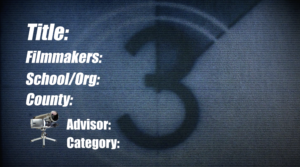Suicide Prevention – Content Scoring Measures:
Be sure to review the disqualifying content information below to learn what to avoid in your film.
The film should communicate a message about suicide prevention that is hopeful and focused on what someone can do to prevent suicide such as reaching out to a friend and seeking support. Images and depictions of people struggling with thoughts of suicide often show them suffering alone and in silence. Instead the film should encourage people to ask for help, reach out to a friend they are concerned about, or to tell an adult if they are concerned about someone. Think of it this way: After someone watches your film what do you want them to do? How do you want them to feel, act or think differently? Here are a few examples of messages your film could communicate.
- Know the Signs: Most people show one or more warning signs, so it is important to know the signs and take them seriously, especially if a behavior is new or has increased and if it seems related to a painful event, loss, or change. Click here to learn the warning signs.
- Don’t keep suicide a secret: It is okay to break a friend’s trust and share your concerns with an adult if you think your friend might be thinking about harming him or herself.
- Reach out for help: The film should encourage people to ask for help, reach out to a friend they are concerned about, or if a person talks about ending his or her life, to take him or her seriously and connect him or her to help.
- Find the Words: Asking someone “Are you thinking about suicide?” will not put thoughts of suicide in his or her mind. In fact, asking this direct question is important.
Tips!
Although picking up someone’s books when they fall is a nice metaphor, it often takes more than “a simple act of kindness” to save a life. Remember that many people don’t know how they should respond to someone who is having thoughts of suicide. Use this opportunity to educate young people and others about what to do, such as talking directly about suicide, seeking help from a trusted adult or calling the National Suicide Prevention Lifeline.
Be Original! For one, be inspired by winning films from the past, but don’t copy their ideas! Since the suicide prevention category talks a lot about warning signs, using actual “signs” as a metaphor is creative and a great way to communicate the warning signs, but we receive a lot of submissions with this approach. Think about communicating the message in a way that will really connect with other young people.
Follow these steps to enter the Suicide Prevention category
- Make sure your film is exactly 60 seconds long.
- The title slide does not count toward the 60-second limit.
- Many of the films (even if they are not winning films) are used to support local awareness efforts and shown in local movie theaters and even on TV. We are only able to use films that meet the 30 or 60-second requirement (based on the submission category you choose).
- Make sure you include the required end slate.
-
- Films must include this end slate which includes a compilation image of logos and the National Suicide Prevention Lifeline. This end slate should appear at the end of your film and within the 60 second limit. Choose one:In addition, you may also include the Crisis Text Line (text “HOME” to 741741) as an additional resource in your film. Learn more about the Crisis Text Line here.
- Black End Slate (png)


- Make sure your film includes the Title Slide
- Download the Title Slide Template here.
 The title slide is not counted in the 60-second limit and needs to include:
The title slide is not counted in the 60-second limit and needs to include:
- Film Title
- Filmmaker (s) names: (these are the youth involved in the filming, editing, or creation of the film)
- School or Organization, Club or Other Affiliation Name
- County (not country)
- Adult Advisor Name
- The Submission Category
- Make sure you have release forms on file for every participant involved in my film.
- anyone else involved in creation of your film must sign a release form, including parent/guardian signatures if they are under the age of 18. Be sure your advisor keeps all release forms on file in case the Directing Change staff asks you to provide them to us. For more information visit the Release Forms page.
- Make sure your film doesn’t include any disqualifying content
- Be sure you’ve reviewed the “Disqualifying Content” section of the submission category of your film to make sure your film won’t be disqualified for including any of this content. For example, if you’re submitting in the Suicide Prevention category, your film should not include portrayals of suicide deaths, attempts, or actions leading up to an attempt (such as a person holding a gun to their head or standing at the side of a ledge). Any films that show this or show any weapons will be disqualified.
*A reminder! – All film submissions should align with safe messaging guidelines and there are specific safe messaging scoring measures for each category which we encourage you to review.
Suicide Prevention Guideline
Every one of us has the power to save a life if we Know the Signs, Find the Words, and Reach Out. Entering a film in this category provides you with an opportunity to share information about suicide prevention, resources and the warning signs for suicide.
Research shows that 60-80% of young people tell a friend that they are thinking about suicide, but less than 25% of those friends go on to seek help for that person. Visit the Know the Signs campaign website for more information about California’s suicide prevention campaign.
Resources
Suicide Prevention Resources to Assist You with Content
For background information review these fact sheets and short educational films developed by the Directing Change Team in collaboration with NAMI California.
For additional questions regarding the “Suicide Prevention” category, please contact us.
Suicide Warning Signs for Youth
Warning signs are indications that someone may be in danger of suicide, either immediately or in the near future. Most people show one or more warning signs, so it is important to know the signs and take them seriously especially if a behavior is new or has increased and if it seems related to a painful event, loss, or change. (www.youthsuicidewarningsigns.org)
- Talking about or making plans for suicide.
- Expressing hopelessness about the future.
- Displaying severe/overwhelming emotional pain or distress.
- Showing worrisome behavioral cues or marked changes in behavior, particularly in the presence of the warning signs above. Specifically, this includes significant:
- Withdrawal from or changing in social connections/situations
- Changes in sleep (increased or decreased)
- Anger or hostility that seems out of character or out of context
- Recent increased agitation or irritability
The following is a list of emergency warning signs that require immediate action!:
- Threatening self-harm or suicide
- Person is in act of self-harm or suicide
- Person has a weapon or other lethal means
- Seeking weapons or means to self-harm
- Talking about death or suicide while acting agitated or anxious, or while under the influence of drugs or alcohol
These warning signs may not signal an emergency situation, but are signs that a person may be in need of help:
- Withdrawing from friends and family
- Hopelessness
- Isolation, loneliness
- Low self-esteem
- Significant personality change
- Dramatic mood changes
- Unusual neglect of personal appearance
- Frequent complaints about physical symptoms, such as headaches, stomachaches, fatigue, etc.
- Loss of interest in pleasurable activities
- Increasing use of alcohol or other drugs
- Putting his or her affairs in order (for example, giving away favorite possessions, or throwing away important belongings)
- Becoming suddenly cheerful after a period of depression (this could be a sign that a person has made a suicide plan)
The Directing Change team is able to provide suicide prevention resources and programs for your school/campus and trainings to help districts meet the requirements of AB 2246. Please contact us.









 The title slide is not counted in the 60-second limit and needs to include:
The title slide is not counted in the 60-second limit and needs to include:





